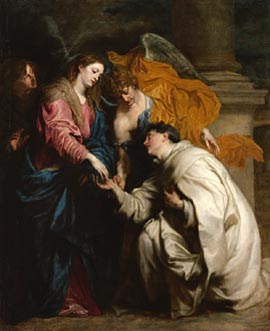 |
 |
 |
 |
 |
|
| Anthony Van Dyck The Vision of the Blessed Hermann Joseph, 1629 or 1630 Oil on canvas, 160 x 128 cm Kunsthistorisches Museum, Gemäldegalerie, Vienna 488 |
||
The blessed Hermann Joseph was born in the middle of the twelfth century in Cologne and probably died in 1241. At age twelve, he entered the Premonstratensian monastery at Steinfeld in the Eifel region. Mystically inclined from early on, he was especially devoted to the Holy Virgin, who according to legend appeared to him several times during his life. He composed sermons and hymns in her honor and received the surname Joseph from his brethren. Thereafter, Mary appeared to him with two angels to consummate a mystical wedding. Precursors to this union can be found in the devotional literature of the late Middle Ages, which reports weddings of female saints to the infant Jesus. Anthony Van Dyck painted this work in 1629 or 1630 as an altarpiece for the Jesuit Confraternity of Bachelors in Antwerp. The artist received the relatively small sum of 150 guilders for his efforts, perhaps because he himself had joined the brotherhood in May of 1628. In 1629, Van Dyck had completed a larger altarpiece for the confraternity, Madonna and the Saints Rosalia, Peter, and Paul, for 300 guilders. The Virgin Mary, to whom the confraternity is dedicated, is the main subject of both altarpieces. The choice of the Premonstratensian monk Hermann Joseph as a model of Jesuit virtue may seem odd. Already Papebrochius attributes it to the desire of the brotherhood's leader, father Hermann Spruyt, to honor his namesake. Others, however, call attention to the fact that the Premonstratensian order had always played an important role in the life of the city. The founder of the order, St. Norbert, was the patron saint of Antwerp and of St. Michael's Abbey, one of the oldest Premonstratensian monasteries. In 1627, relics of St. Norbert were relocated to Antwerp. Subsequently, Joannes Chrysostomus van der Sterre, prior of St. Michael's, wrote a biography of Hermann Joseph with a description of the "mystical union" that clearly inspired Van Dyck's painting. In the wedding staged by Van Dyck, the right hand of the Virgin touches the kneeling monk's open palm, supported by the angel. The power of Van Dyck's art emanates from the psychological treatment of the human figures. The visionary state is expressed without ecstatic agitation; instead, the emotional scale is limited to grace and affection. The composition may have been inspired by The Vision of St. Francis Xavier by Gérard Seghers, commissioned by the Jesuit church in Antwerp. It is conceivable that the padres of the professed house themselves brought this work to Van Dyck's attention. Rubens's The Vision of St. Teresa of Avila (1614/1615, original lost) for the Carmelite church in Brussels might have exerted an even greater influence. The comparison of these two masters brings their fundamental differences into sharp focus: Rubens highlights the plasticity of the figures, modeled after classicist ideals; Van Dyck emphasizes the relationship between the protagonists of the depicted tableau. —Karl Schütz |